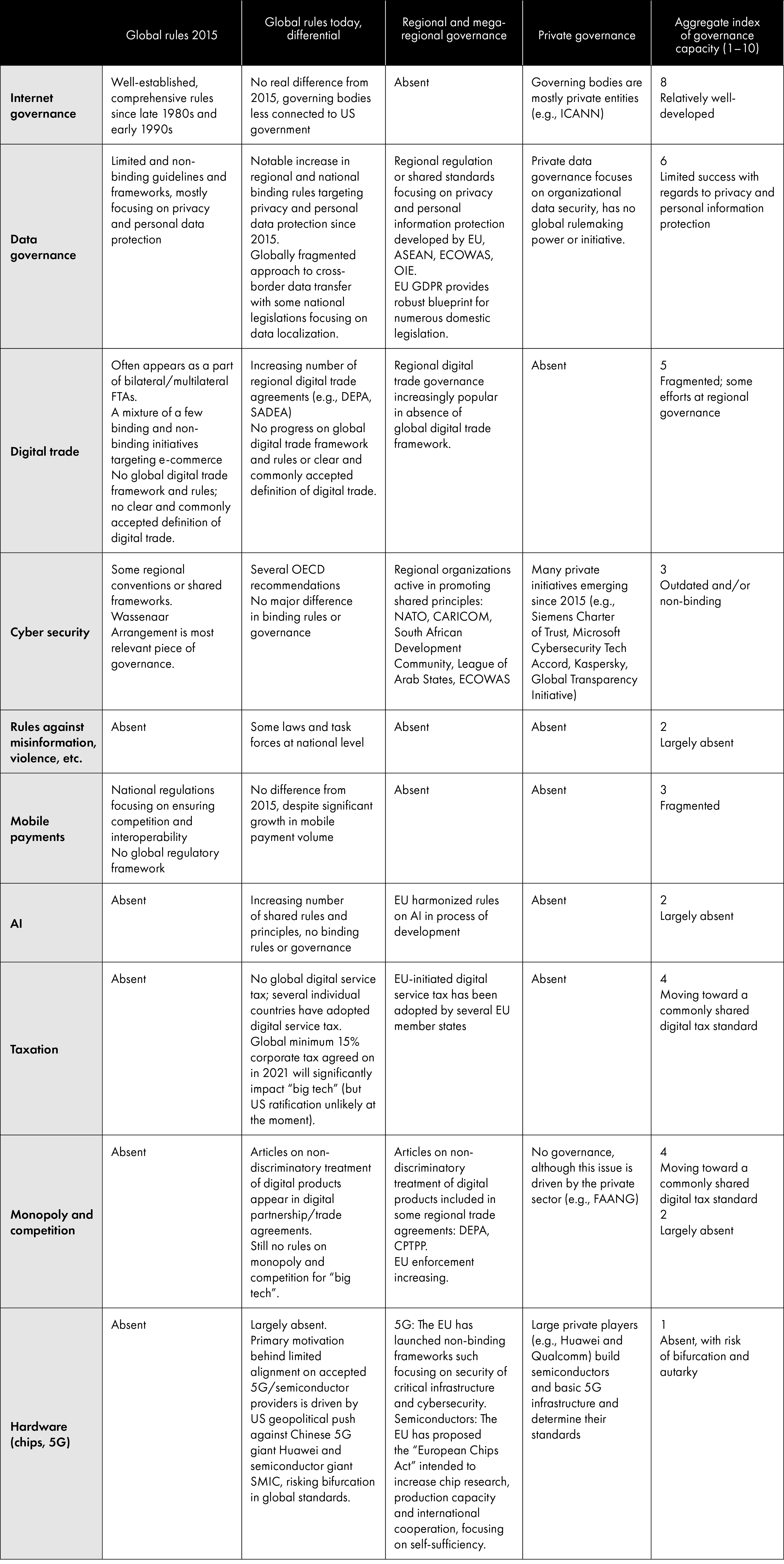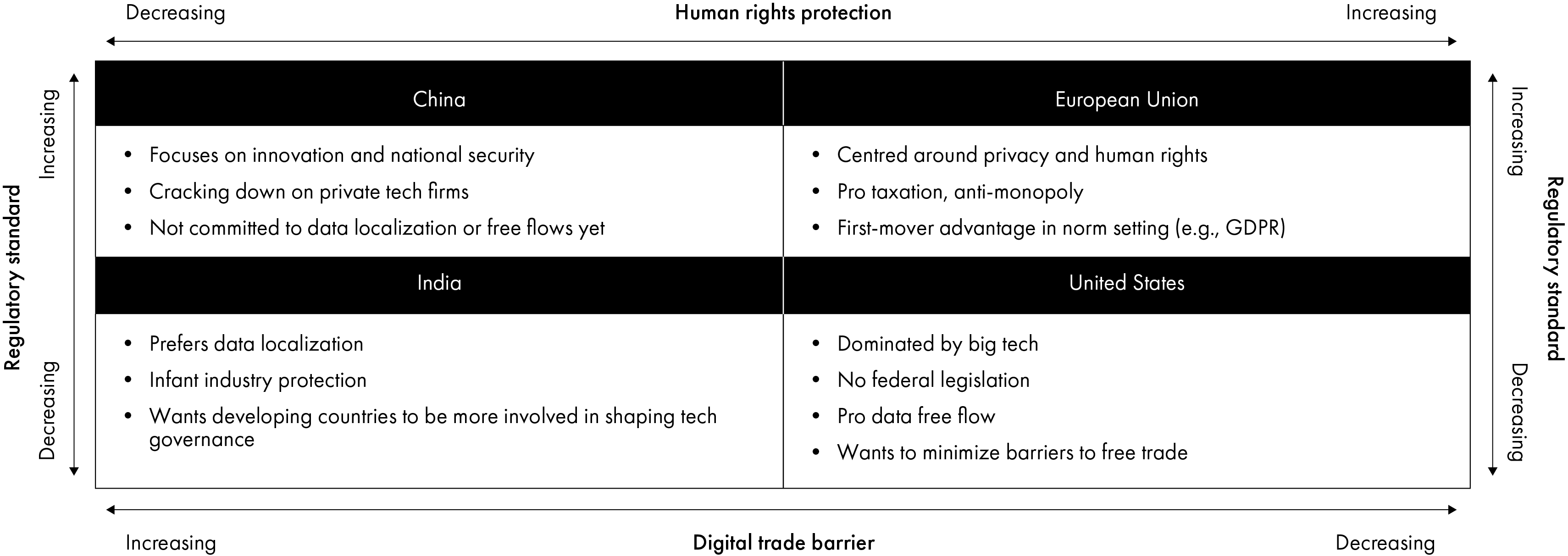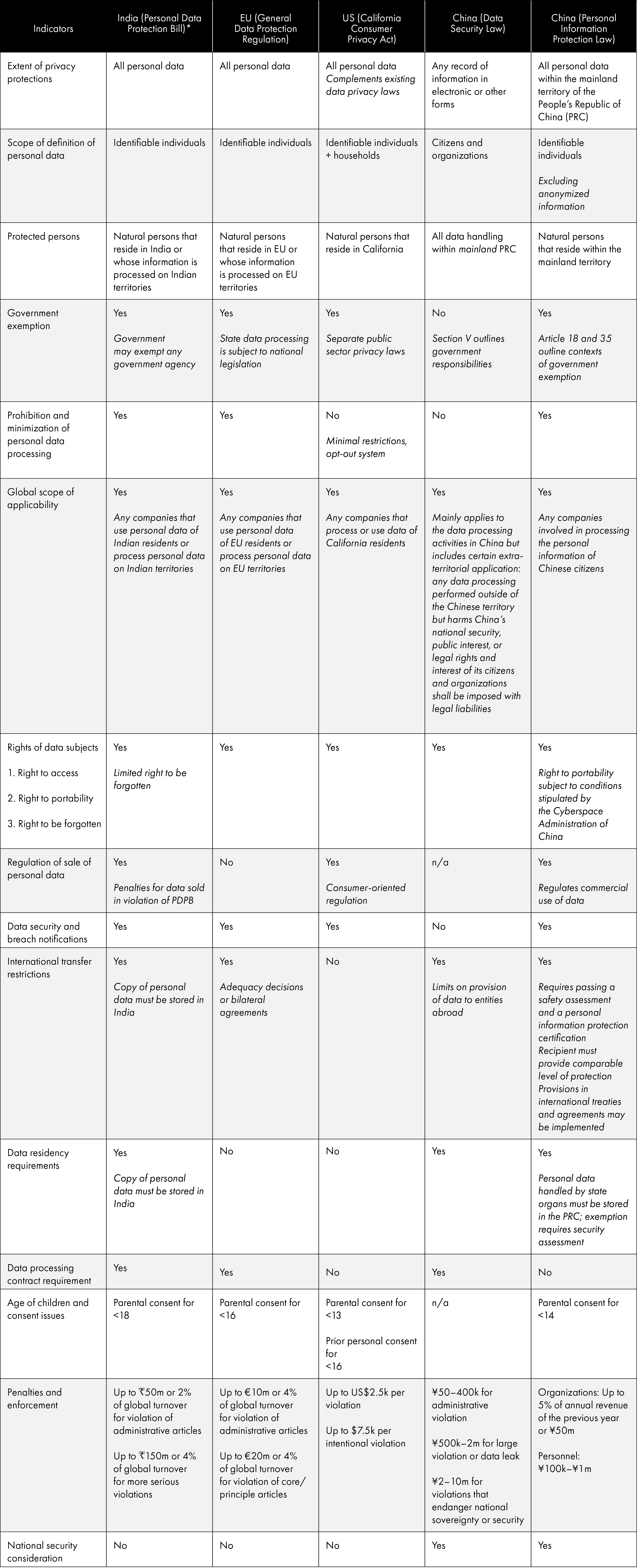Introduction
Many of the dangers we face indeed arise from science and technology — but, more fundamentally, because we have become powerful without becoming commensurately wise. The world-altering powers that technology has delivered into our hands now require a degree of consideration and foresight that has never before been asked of us.
— Carl Sagan 1994, 316–17
We are facing an ever-growing gap between the phenomenal acceleration of technology and of connectivity, and the human capacity to manage these trends. The gap is well-documented in the fields of finance, climate change, pandemics and nuclear risks. But the contrast between the exponential growth of disruptive technology and the lacklustre supply of governance mechanisms is starkest in the fields of digital governance and artificial intelligence (AI).
That gap becomes existential when we consider the likely future development of artificial general intelligence (AGI) (Ord 2020) or superintelligence (Bostrom 2015) that can be misaligned with human values or even the goal of ensuring the continuity of human existence. This question of the governance of life with AI may be the most essential question of our time (Tegmark 2017), but you would not know it from the current output of global governance in this field. Summarizing the judgement of many scientists in the field, Toby Ord argues that unaligned AGI is actually the number-one global existential risk for humanity, with a 10 percent chance of human extinction within 100 years. The prophesized existential threats posed by extreme and accelerated technological advancement and expansion have never been as close to reality as they are now. As noted by Yuval Noah Harari and Daniel Kahneman (2021) in a recent conversation, the task of taming and governing the digital/AI revolution is daunting. Humanity may have no slack for a mistake this time around, given the existential consequences of such a mistake.
Today, we already benefit from tremendous digital or AI innovations in e-commerce, social media and communication, home management, work, health care, education, transportation, and entertainment (West and Allen 2020). We can foresee that AI-driven algorithms may soon be able to correct human judgement flaws (or noise) caused by fatigue, irregularity, emotions and other weaknesses, afflictions that can generate variation in decisions by up to 50 percent (Kahneman, Sibony and Sunstein 2021). Within two decades, we can envisage a world with generalized deep learning and virtual reality, computer vision, contactless love, fully autonomous vehicles in most advanced and emerging economies, autonomous weapons in militaries and a dream of plenitude (Lee and Chen 2021).
Yet, today, we witness tremendous havoc created by the explosion of social anger, exacerbated by sophisticated social media algorithms, deep polarization, the return of tribal politics, the loss of agreed truths and the spread of misinformation and dangerous conspiracies, the loss of privacy, the rise of massive and uber-powerful tech companies, and massive job displacement and inequality (Bartlett 2018). Influence operations by foreign states have also amplified such social anger and polarization in many democracies, adding a degree of external threat and urgency. We also live with a world of security-driven digital decoupling between the United States and China (Ma 2021). In other words, the digital revolution is moving faster than the human capacity to cope with it, embed it within a public good-oriented framework and steer its disruptive power toward a non-destructive direction.
The problem is visible at the national level but particularly salient at the global level. Digital/data governance is fragmenting among at least four poles: a US model with maximum innovation and limited regulation; an EU model with a strong regulatory balance; an India model with an emphasis on digital sovereignty and infant industry protection (applicable to other developing countries); and a Chinese model with both rapid innovation, strong state control and surveillance. Our global governance capacity is affected by multiple splits: a US-EU split over privacy, tax and anti-monopoly regulations; an India-West split over data ownership and first-mover advantage; and, worst of all, a potential digital cold war between the United States (and its allies) and China. In response to this dire need for governance, Rohinton P. Medhora and Taylor Owen (2020) have proposed a need for a new fundamental effort at coordinated governance — or a “digital Bretton Woods.” While fundamental international conditions and global distribution of power today differ drastically from the Bretton Woods era, a high-stake and fragmented digital world is in dire need of such renewed cooperative spirit.
Recognizing the gap in digital governance, we ask the following questions: What is the scale of the gap in governance relative to requirements needed to keep the digital economy afloat? And what could be a pathway forward in the context of the growing securitization and increasing divides?
It is urgent to raise a sense of awareness, mobilize all social and public actors around this urgent dilemma and catalyze a multi-level effort to address this conundrum. We argue that no global, regional or national institution alone will be able to deliver the right governance capacity. Instead, we recommend a highly reactive, innovative and competitive model of networked governance that operates at multiple levels with key nodes and catalysts.
Governance innovation must keep pace with technological innovation. Given how far the digital cold war has already proceeded and the currently low capacity to cooperate between the United States and China, part of the solution will need to involve clubs and alliances of countries and non-state actors. At the same time, some level of global coordination and basic rules for global co-existence are crucial for success in managing this existential threat. The Group of Twenty (G20) is one critical venue for such work, even though it has not delivered so far.
Key Indicators on the Exponential Rise of the Digital Economy
Over the last few years, and particularly during the COVID-19 pandemic period, the digital economy has experienced an exponential rise and begun to transform human interactions, production and trade (Suominen 2019). In Table 1, we offer a review of selected indicators on cross-border data flows and digitalization. It is clear that digital trade and cross-border data flows, along with other digital innovations, are rising faster than physical trade flows.
Table 1: Summary of Key Indicators on the Explosion of the Digital Economy

Table 1 shows that key components of the digital economy, including e-commerce, AI economy and cross-border mobile payments, have experienced steady growth since 2017, and are projected to continue growing. 2020 saw the sharpest growth in several components, likely due to mobility constraints and increased reliance on digital tools associated with the COVID-19 pandemic. While current data illustrates useful trends, it is important to note that the volume of digital trade — a key component of data on the digital economy — is very hard to measure.1 This is in part due to the lack of a shared definition of what constitutes digital trade, highlighting a need for technocratic standardization as a basis for high-level digital governance.
Why Addressing the Digital Governance Gap Matters
We offer here a typology of risks involved in the digital governance gap:
- Under-institutionalized markets (North 1990; Williamson 1985): All markets require basic rules and governance to ensure trust, accountability and resilience, and to prevent abuse by potential oligopolistic players. Global markets require global institutions. Digital governance is a new domain, where innovators and disruptors have been able to run ahead of rule making. We are emerging from more than two decades of an under-institutionalized digital economy, in which many large imbalances and market deficiencies are appearing in every society around the world.
- Unprecedented power of digital companies: The current moment may be the first time in human history that a private company such as Facebook (Meta) has the ability on its own to screen messages of leaders and politicians from every country in the world, except China, North Korea, Cuba, and maybe Iran. And this global function is only peripheral to Facebook’s core business, with just hundreds of assigned staff. In other words, Facebook, along with Twitter and a couple more giant for-profit digital companies, has acquired in less than 15 years the power to control information, emotions, narratives and political/social mobilization in the majority of countries of the world, including the United States. And they are generating disproportionate profits from this dominant position. All this is taking place in a near complete vacuum of digital governance. Most countries outside the United States and China have limited power to regulate and control these US-based and China-based global digital companies. The US government retains residual power to do so, but has been unable to act due to constitutional constraints and great polarization in Congress. China (behind its internet firewall) has already started wrestling with this power and cracking down on its own giants. India has started to pass restricting measures on the power and freedom of social media companies on its territory. The European Union is taking its own regulatory path through the General Data Protection Regulation (GDPR) and its successor currently under negotiations, as well as tough competition rules, within the constraints of its relative weak position in the space (no EU-based digital giants). But the governance gap remains enormous in the United States and many other countries, as well as at the global level.
- Risk of explosive social disruptions and inequality: The scale of disruption induced by digital and AI innovation under current intellectual property protection and lack of redistribution accrues immense winner-take-all benefits to first movers. We are witnessing at the same time a historic concentration of capital and wealth and growing numbers of displaced or laid-off workers in declining industries. We can soon expect to have digital entrepreneurs with a net worth of US$1 trillion (from a quarter of a trillion so far with Elon Musk and Jeff Bezos), alongside massive job displacement. Such fast-paced social dislocation and inequality could prove politically explosive and very hard to manage (Lee 2018). No social system is ready — and the global governance is not ready either. The viability of modern states is also at stake, as their revenue base keeps eroding. In the late nineteenth century, when the oil and railroad revolutions generated a similar concentration of wealth, it took all the power and energy of a Teddy Roosevelt to tame these forces. We don’t have such capacity today.
- Global systemic risks: The global digital economy is extraordinarily interconnected and fast-paced. It encompasses data flows, e-commerce, mobile payments, digital currency (with increasing future prevalence), AI algorithms, fully automated cars and weapons. Is the current system resilient against contagion effects or collapse? What is the safety net in case of a crisis?
- Loss of privacy and potential loss of human freedom: The rise of the surveillance state is an extreme reality in China, including in repression operations. But it is also a reality all over the world. Companies such as Google and Facebook not only have more data about each individual than they can imagine, but also the capacity to couple this data with future AI algorithms for all kinds of usage. For the first time in human history, most humans have handed over fundamentally private information to either giant private actors, states or both. Even worse, regulatory breaches (cf. Cambridge Analytica) give political or criminal actors access to important and strategic data, with which they can manipulate human psychology.
- Democratic existential crisis: The explosion and equalization of information, and the intensification of complexity, have eroded any sense of agreed truth and reality within most nations. Social media has unexpectedly accelerated polarization, amplified echo chambers and closed loops among like-minded individuals, greatly contributing to extreme polarization in many societies across the planet. Absurd conspiracies can spread virally and inspire violent actions by large spontaneous groups, as shown by the January 6 insurrection in the United States (with a large number of people mobilized by QAnon beliefs). At a deeper level, new understandings about the concept of extended mind in psychology show that humans are increasingly delegating part of their thinking processes to smart phones and their algorithm-driven suggestions devised to serve profit-seeking companies (cf. work by Peter Reiner).2 Human behaviour may be profoundly changing in ways never seen before, which our democratic institutions are not ready for. Facebook’s move to a metaverse world that can attract humans to spend time and to be transformed in a totally unregulated environment has the potential to further increase this risk.
- External cyberthreats to democracy: The current digitalized world is also increasingly used as a tool to undermine democracy from the outside. Russia’s interference in the 2016 American presidential election through social media campaigns highlights the extent to which an unregulated digital sphere could undermine democratic institutions. China’s propaganda efforts on platforms such as Twitter and YouTube during the 2020 Taiwanese presidential election are yet another example that an unregulated cyberspace could warrant injudicious digital campaigns. More recently, the sale of Israeli spyware Pegasus to various governments — who in turn used it for malicious efforts against other states, and individuals such as journalists, reporters and human rights activists.
- Rise of cybercrimes, cyberpiracy and cyberattacks (Deibert 2013, 2020; Sanger 2018). The open structure of the internet has left great space for hackers and organized gangs. Worse, the existence of an illegal black market incentivizes smart young digital talents in many places around the world to look for zero-day loopholes in operating systems and sell those to the highest bidders, including the national security agencies of many countries (Perlroth 2020). This quickly escalates into a growing cyberspying competition and even cyberwar (Segal 2016).
- Fragmentation of the internet and of the digital economy into rival spheres (splinternet), and weaponization of interdependence (Drezner, Farrell and Newman 2021; Farrell and Newman 2019; Ma 2021; Suominen 2019). The raising of stakes in the digital economy, the sudden acceleration of the digital transformation in China, the intensification of security competition and the high prevalence of dual-use technologies in the digital/AI space have led to an increasing potential for a digital cold war, as well as other fractures among various regional poles. As Winston Ma (2021, 42) writes: “all in all, U.S.-China tech decoupling is real and accelerating. Hence, the digital economy is in a vital conflict and crisis: the global tech world, together with at least part of the world economy, is now fractured into two-and potential more…spheres of influence, whereas tech entrepreneurs are driving the prospect of a technological singularity, hyper-connected society, and internet of everything.” This decoupling is extremely risky, because it is abrupt, driven by fears and not negotiated. It leads to highly explosive tit-for-tat measures that are hard to contain. This process massively interferes with the human effort to generate a global governance framework.
Measuring the Digital Global Governance Gap
In Table 2 (and, in greater detail, in Annex 1), we offer a summary of existing digital governance at the global, regional, club or national levels. Overall, we evaluate that the governance of basic internet functions remains surprisingly resilient (8/10), but other dimensions of digital and AI governance are extremely weak (2/10 in most cases).
One powerful indicator that highlights the gap between the risks outlined above and the current state of global governance is found in the recent G20 Rome Leaders’ Declaration. The focus remains on sharing the gains of digital innovation for the green economy, education and economic growth. However, the digital economy gets only brief mentions toward the latter part of the declaration with generic and toothless statements such as the following:
“In cooperation with social partners, we will adopt human-centered policy approaches to promote social dialogue and to ensure greater social justice; safe and healthy working conditions; and decent work for all, including within global supply chains. To reduce inequalities, eradicate poverty, support worker transitions and reintegration in labour markets and promote inclusive and sustainable growth, we will strengthen our social protection systems” (G20 Leaders 2021, para. 35).
“We recognize the role of technology and innovation as key enablers for the global recovery and sustainable development.…With this in mind, we will work to strengthen bilateral and multilateral cooperation to secure our ICT, address shared vulnerabilities and threats, and combat cybercrime” (ibid., para 46).
“Well aware of the benefits stemming from the responsible use and development of trustworthy human-centered Artificial Intelligence (AI), we will advance the implementation of the G20 AI Principles” (ibid., para 47).
“We will also continue to further common understanding and to work towards identifying commonalities, complementarities and elements of convergence between existing regulatory approaches and instruments enabling data to flow with trust, in order to foster future interoperability. Recognizing the responsibility of digital service providers, we will work in 2022 towards enhancing confidence in the digital environment by improving internet safety and countering online abuse, hate speech, online violence and terrorism while protecting human rights and fundamental freedoms” (ibid., para. 48).
This summary of current global digital governance reveals the extent of the gap with what is at stake!
Table 2: Evaluation of What We Have and of the Gap to a Functional Global System, under Conditions of Securitization and Great Power Rivalry

From Table 2, we can draw several important lessons. First, the well-established nature of internet governance shows that governance in the digital domain is indeed possible. Internet governance was established several decades ago and is operated by largely independent and apolitical entities. However, times have changed. It is important to recognize the current geopolitical stakes and inherent international context that now constitutes multi-polarities of interest. Second, despite the absence of a centralized governance mechanism for digital trade, the language and framing of rules on digital trade as expressed in recent free-trade and digital partnership agreements are increasingly similar, and indicate some degree of convergence in the governance of digital trade. Finally, the domain that fairs most poorly in terms of governance is also the domain that is most politicized. The primary motivation behind limited alignment on accepted 5G or semiconductor providers is driven by the US geopolitical push against Chinese 5G giant Huawei and semiconductor giant SMIC, risking bifurcation in global standards and encouraging autarkic behaviours such as the EU idea of “chips self-sufficiency.”
As a reference, Figure 1 offers a comparative summary of different approaches used by the United States, European Union, China and India. For a more detailed look at key legislation shaping digital governance in each jurisdiction, refer to Annex 2.
Figure 1: Four Competing Approaches to Digital Governance

Conclusion and Global Digital Governance Proposals
- There is a huge disconnect between the speed of technological development, the scale of existential risks involved, and the acceleration of securitization on the one hand and the supply of national/global governance and increase in human capacity on the other hand.
- Political leaders are not yet incentivized to deal with this existential set of issues. They are distracted by short-term political urgencies and the acceleration of tit-for-tat rivalry.
- A digital Bretton Woods captures the spirit of global digital governance we should strive for. However, it is essential to recognize the radically different context of today compared to 1944. The lack of “global yearning for peace and stability” highlighted by Medhora and Owen (2020), is further aggravated by a new environment of multi-polarity and diffused interests. Thus, we may only be able to reach a thin global framework under current geopolitical conditions, and it can only be part of a larger multi-level and partly competitive effort to generate governance capacity.
- The human solutions to the predicament cannot come from a single locus or look like responses to past governance issues. There will need to be multiple entry points with a networking and competitive dynamic among them — some from the G20, World Trade Organization (WTO), United Nations, some from club governance (Group of Seven [G7], Quad, China-based solutions, along with bilateral forums such as the US-EU dialogue), and some from private actors, civil society networks, think tanks and academic actors.
- For any critical mass process of capacity development to occur in such a way, both catalyzing focal points and elements of coordination will be required. The global level may yet play a key signalling role or allow minimum convergence on dimensions of common interest. The G20 urgently needs an upgraded high-level working group on all digital governance questions.
- It is also critical to develop rules for co-existence similar to arms control agreements for the large part of the digital and AI economy that is going to be fully decoupled and fragmented, especially between China, Russia and the Western world.
Annex 1: Detailed Look at Current Digital Governance Tools and Policies

Annex 2: Comparative Look at Key Indicators in Data Protection Legislations




